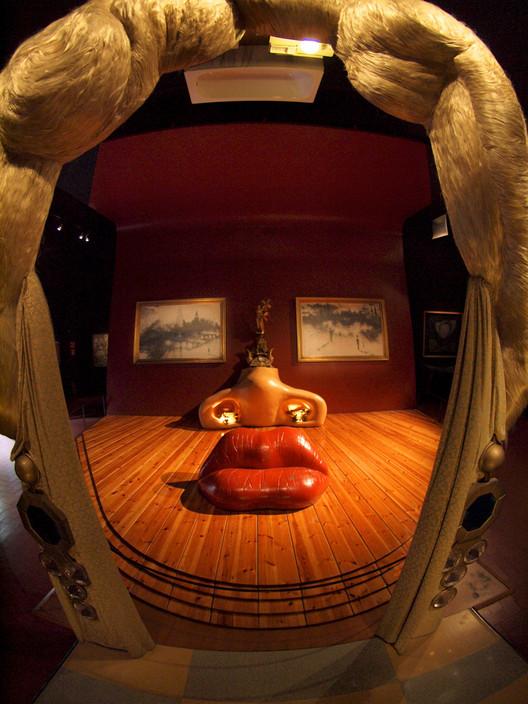
In 1924 writer André Breton penned the Surrealist Manifesto, which called to destabilize the divides between dreams and reality, between objectivity and subjectivity. For many architects who had been—and continue to be—interested in the fundamental role of the built environment, Breton’s surrealist thinking provided a rich resource to examine the role architecture plays in forming reality. Since then, from Salvador Dali and Frederick Kiesler to Frank Gehry, Surrealism has profoundly shaped architecture in the 20th century.

Surrealist artists were always fond of architecture—particularly the interior. Drawing on the unsettling and hyper-rational “Ideal Cities” of the Renaissance, Italian artist Giorgio de Chirico crafted haunting dream-like scenes of urban spaces populated with neoclassical structures, sculptures, and medieval fortresses contrasted with industrial chimneys and the faint puffs of a stream engine beyond. Likewise, the Belgian painter René Magritte transformed the architecture of everyday life into perplexing symbolic images. In Time Transfixed (1938), what appears to be a functioning toy engine phases through the mantlepiece of a Victorian interior to occupy the hearth. The familiar domestic scene becomes an arresting image that symbolically addresses the speed of new methods of travel and their implications on domesticity.

Even Salvador Dali, perhaps the most infamous surrealist artist, engaged the built environment. Moving beyond the melting planes of his iconic scenes, Dali produced the Mae West Lips Sofa between 1937 and 1938 in collaboration with his longtime British patron Edward James as an extension of the illusory collaged drawing Mae West’s Face which May be Used as a Surrealist Apartment (1934–1935). Later, in 1974, the sofa was later included in a full-scale construction of the salon, which resembles the iconic actress’ face in three dimensions, created with the assistance of architect Oscar Tusquests.

However, the most famous correlation between surrealism and architecture came in the form of a decade-long project by Austrian-American architect Frederick Kiesler. After relocating to New York from Vienna in the early decades of the 20th Century and after his association with the De Stijl movement, Kiesler worked on an exhibition for Peggy Guggenheim, as well as collaborated with both Marcel Duchamp and Andre Breton on the design of the “Salle Superstition” for the “Exposition Internationale du Surréalisme” in Paris in 1947.

Following his work with the Surrealists, Kiesler began to focus extensively on his most notable project—the Endless House. The conceptual project built on his previous designs for the Endless Theatre as well as his own theory of Correalism, in which Kiesler argued for the importance of the dynamic correlations between objects, spaces, and human experience. According to Kiesler, “sculpture, painting, architecture should not be used as wedges to split our experience of art and life; they are here to link, to correlate, to bind dream and reality.” In the lineage of the surrealist painters, Kiesler's house sought to dismantle the divide between the real and the more-than-real brick by brick.

While the project remained unbuilt, a series of studies from 1947–1960 reveal Kiesler’s fascination with the architectural adoption of surrealism. His initial ovoid, biomorphic structure evolved steadily into the intersecting cavernous volumes defining his concept model and drawings now housed at MoMA. Like Dali, De Chirico, and Magritte, Kiesler sought to create an interior that rendered the space of the home a psychological landscape—both foreign and familiar. Each element of the Endless House was designed to poetically manifest the essential elements of dwelling. Forgoing doors, spaces folded into one another, only delineated by their materiality, while furniture folded out of the womb-like interior walls and a travelling light followed occupants throughout the seemingly endless volume.

In 1962, only two years after the culmination of Kiesler’s Endless House in the exhibition “Visionary Architecture” at MoMA, Kevin Roche, John Lacey, and John Dinkeloo completed work on the TWA Flight Center in Queens designed by Eero Saarinen, who passed away the year before its completion. The soaring canopies of concrete drew on advancements in construction and engineering to produce interior spaces that seemed to defy the laws of physics. In parallel, Japanese architects associated with the Metalist Movement, such as Kiyonori Kikutake and Arata Isozaki, produced concepts for sublime utopian cities of floating concrete forms.

“Surrealism is destructive, but it destroys only what it considers to be the shackles limiting our vision,” Dali once said. Thus, it was inevitable that the formal logic of surrealist art would be co-opted by architects associated with the late 20th-century movement Deconstructivism. Frank Gehry’s own residence from 1978 and the 1989 Vitra Design Museum translate the photographic collage of Dali’s Surrealist Apartment into arresting compositions of autonomous forms colliding into one another. Whispers of this architectural pastiche can be seen in the intersecting platonic forms of Bureau Spectacular’s speculative works.

Today, photographic artists like Victor Enrich fold, bend, stack, and topple modernist structures into uncanny and aberrant illusions in the tradition of architecture’s interest the surreal. It is telling that a new compendium for Architectural Design titled “Celebrating the Marvellous: Surrealism in Architecture” was released this March—the first since the 1978 special issue of Architectural Design on “Surrealism and Architecture” 40 years prior—amid our increasingly surreal social and political landscape. While surrealism has played and continues to play a crucial role in contemporary architecture, the influence of surrealist structures and imagery have largely gone unnoticed. In the modern world—where the real, the more-than-real, and the hyper-real are almost indistinguishable—surrealism has flourished as the unseen logic behind architecture's continual shaping and questioning of reality.

